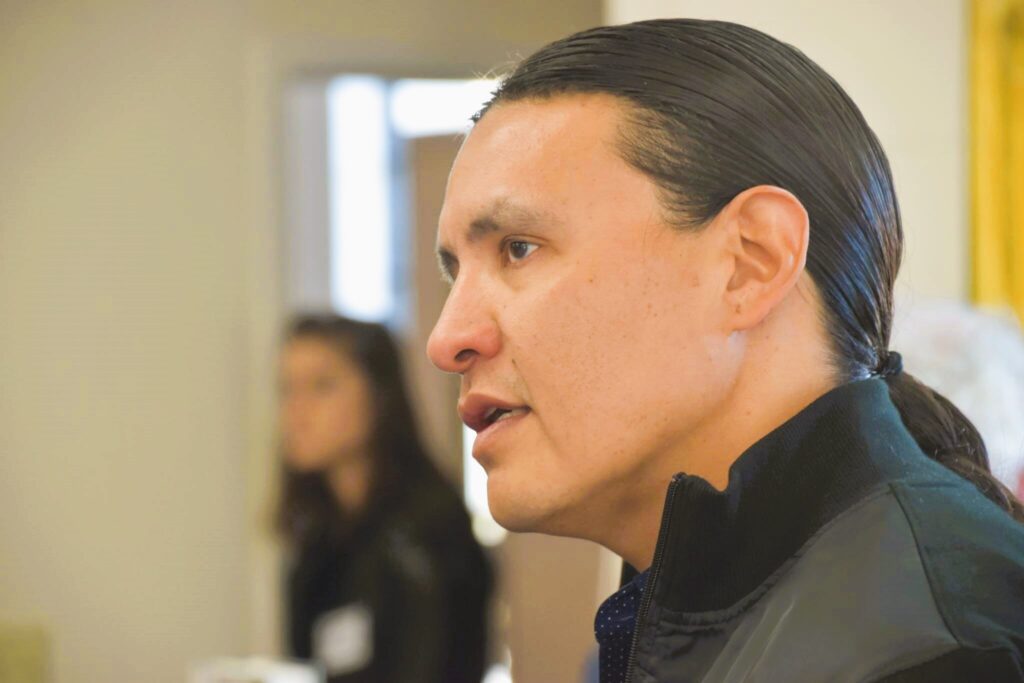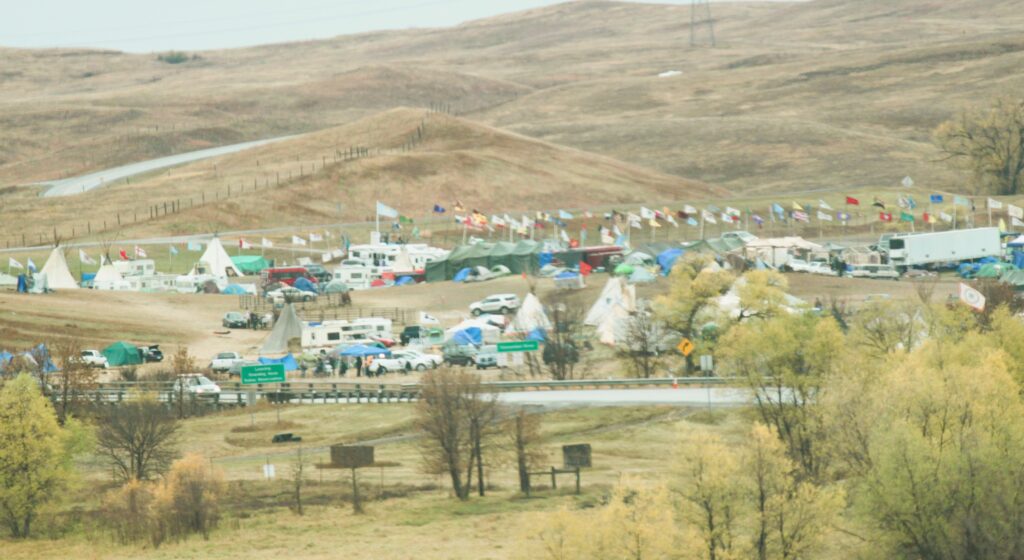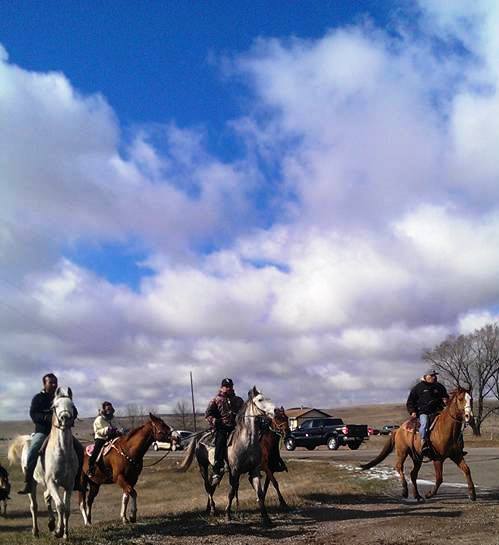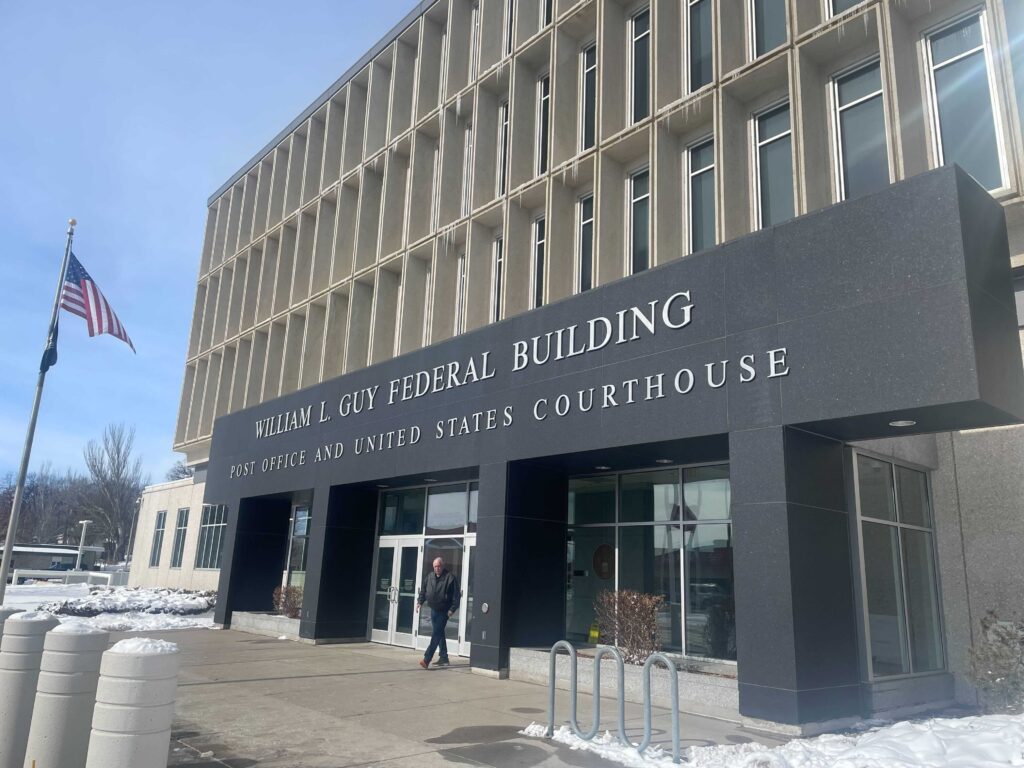
Native-led prayer camps established in opposition to the Dakota Access Pipeline supported the Standing Rock Sioux Tribe’s legal demand for the Corps of Engineers to refuse a Missouri River crossing permit. (Photo by Talli Nauman)
Editor’s Note: Reporter Adrianna Adame contributed to this story and attended the trial.
A federal judge soon may receive the first Indigenous testimony in four weeks of hearings on North Dakota’s $38-million suit against the U.S. Army Corps of Engineers. The case seeks federal remuneration for state law enforcement costs in patrolling Native-led prayer camps established in opposition to the Dakota Access Pipeline.
Set to testify, Oglala Lakota tribal citizen and attorney Chase Iron Eyes must appear because the defense subpoenaed him. “North Dakota wants to cast this as a situation where violent out-of-state protestors took it over, and that’s not the case,” Iron Eyes said.The pipeline opposition “is a reassertion of tribal nationhood, of Indigenous sovereign integrity,” he told Buffalo’s Fire.

In 2016-2017, tens of thousands of self-described water protectors from around the world gathered near the oil pipeline’s slated Missouri River crossing construction site. They set up prayer camps supporting the Standing Rock Sioux Tribe’s legal demand for the Corps of Engineers to refuse a crossing permit. This was the longest “protest” North Dakota had ever experienced, according to courtroom testimony heard Feb. 26 in the state capital of Bismarck.
The Corps has jurisdiction over Energy Transfer, a privately owned energy company and DAPL owner. The corporation’s oil line crosses the Missouri River just a mile upstream from the tribe’s drinking water intake. The federal agency, however, has no law enforcement authority of its own.
So, North Dakota took part in crowd control through a multiagency “unified command” partially funded by the oil company and orchestrated by the company’s TigerSwan LLC. The state’s Private and Investigative Security Board later sued that international counterinsurgency surveillance firm for operating without a license.
Meanwhile, then-Gov. Jack Dalrymple declared a state of emergency. He augmented the joint task force by calling out the National Guard “to free up law enforcement,” according to the recent testimony in North Dakota U.S. District Judge Daniel M. Traynor’s courtroom.
The American Civil Liberties Union has criticized Dalrymple’s moves as overreaction, saying, “North Dakota’s government suppressed free speech and militarized its policing.”
North Dakota Gov. Doug Burgum testified on Feb. 26 that the United States should pay for the DAPL response costs. “Instead of evicting protesters from federal lands, the U.S. government enabled and encouraged protesters to use Corps land as a home base to launch their often violent and illegal protests,” he said. “It’s time for the feds to pay up and make North Dakota whole,” according to a media release from the governor’s office.

In response to Burgum’s testimony, Iron Eyes expressed disappointment with the governor for asking the federal government to pay $38 million to North Dakota. “He said the Army Corps gave permission for protestors to be there, but in the legal view, any sovereign derivative of the Great Sioux Nation doesn’t need any permission to be where we were at. That is our right to be there,” Iron Eyes said.
Historically, the United States has infringed on treaties with American Indian tribes, often regarding their land. The Great Sioux War of 1876 consisted of battles by the Lakota and Northern Cheyenne against the United States over the Black Hills in the Northern Great Plains. The Agreement of 1877 took away land from the Great Sioux Nation and established Indian reservations.
“The only reason we’ve never been allowed to be there is because the times we were outside of those boundaries, we were declared hostile and were killed,” said Iron Eyes. “We had to fight battles with the United States Army. Then we were confined to the modern-day reservation.”

National Security Intelligence Specialist Terry VanHorn from the U.S. Attorney’s Office testified on Feb. 29. Asked if he knew of Chase Iron Eyes, he said he remembered Iron Eyes speaking throughout the protest and described him as an instigator. Iron Eyes would highlight “issues that weren’t relevant,” VanHorn said.
Iron Eyes described his role during the protests as providing legal interpretation to tribal leaders. He said the state of North Dakota mischaracterized what occurred and that the U.S. Army Corps was illegally occupying the land the pipeline is on.
“For these European settlers to say that I am a terrorist or I am an instigator is something we are going to take issue with,” said Iron Eyes. “Our people, Native people, have defended these lands and these waters from all enemies.”
North Dakota “is making billions; they have funds generated from oil and gas activities,” said Iron Eyes. “They need to hold the foreign corporate extractive industry accountable and not try to push the blame onto the federal government.”
VanHorn said the dissidents were “peaceful for the most part.” He said the Corps tried to stay on good terms with them and tribal officials from the Standing Rock Sioux Tribe. An Aug. 22, 2016 email by Intel noted that if DAPL continued to be built, then there was the risk of violence during the protests.
A video in the trial captured an encounter between Omaha District U.S. Army Corps of Engineers Commander Col. John W. Henderson and an Indigenous water protector who said, “You have blood on your hands. What you did was oppression and genocide.”

Judge Traynor has been overseeing a related case, Thunderhawk v. County of Morton, it is a class action discrimination suit by water protectors against Dalrymple and the rest of the authorities for barricading the passage around the camps. The judge has ruled plaintiffs supplied evidence of “sufficient facts to show the defendants’ closure of the road in question constituted a per se unconstitutional prior restraint” and “to show a violation of their freedom of speech.”
Energy Transfer, a Fortune 500 company, lost a Strategic Lawsuit Against Public Participation, SLAPP, suit demanding $900 million from environmental organizations for supporting the water protectors.
Iron Eyes wants North Dakota and the United States to acknowledge the Standing Rock Sioux Tribe was within its rights.
“They’re going to consistently fight with us and try to erase us and not recognize our sovereign status,” said Iron Eyes. “What they frame as protests were not unlawful under the United States Constitution.”
In attendance at court, in attendance at prayer camps
Nauman, T. (2020, October 15). Standing rock water protectors sue police, security forces. The Esperanza Project. https://esperanzaproject.com/2020/native-american-culture/standing-rock-water-protectors-take-tigerswan-security-to-court/
Pruitt, S. (2020, November 10). Broken treaties with Native American tribes: Timeline. History.com. https://www.history.com/news/native-american-broken-treaties
State of North Dakota. (2024, February 26). Burgum testifies in a trial seeking reimbursement from the U.S. government for $38M in DAPL response costs. North Dakota Office of the Governor. https://www.governor.nd.gov/news/burgum-testifies-trial-seeking-reimbursement-us-government-38m-dapl-response-costs

